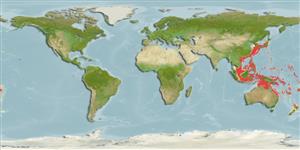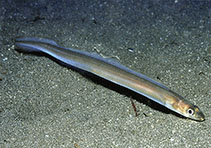Masukkan pemerhatian anda di Fish Watcher
| Native range | All suitable habitat | Point map | Year 2050 |

|
| This map was computer-generated and has not yet been reviewed. |
| Ariosoma anagoides AquaMaps Data sources: GBIF OBIS |
muatnaik fotos/gambar dan video
Pictures | Videos | imej GoogleAriosoma anagoides
Picture by Tonozuka, T.
Pictures | Videos | imej GoogleAriosoma anagoides
Picture by Tonozuka, T.
klasifikasi / Names Nama-nama umum | Sinonim (persamaan) | Catalog of Fishes(Marga, Jenis) | ITIS | CoL | WoRMS | Cloffa
> Anguilliformes (Eels and morays) > Congridae (Conger and garden eels) > Bathymyrinae
Etymology: Ariosoma: Greek, ari = very, strength, superiority + Greek, soma = body (Ref. 45335).
More on author: Bleeker.
Etymology: Ariosoma: Greek, ari = very, strength, superiority + Greek, soma = body (Ref. 45335).
More on author: Bleeker.
Environment: milieu / climate zone / depth range / distribution range Ekologi
laut dasar (demersal); kisaran kedalaman 10 - 250 m (Ref. 86942). Tropical
Penyebaran Negara-negara | Daerah-daerah FAO | Ecosystems | Kemunculan | Point map | Introduksi | Faunafri
Western Pacific: Kanagawa Prefecture, Japan southward to the East China Sea and the East Indies.
Size / Weight / umur
deskripsi pendek Kunci identifiaksi (pengenalan) | Morfologi | Morfometrik
duri punggung lunak (Keseluruhan (total)) : 170 - 196; Sirip dubur lunak: 122 - 145. Large and distinctive eye with a vertical elongated pupil and white blotches (Ref. 48635).
Occurs in shallow sandy and muddy bottoms (Ref. 48635). Benthic (Ref. 75154). Several similar species throughout the Indo-Pacific (Ref. 48635). Rarely seen and usually at night on sand, rubble and mud bottoms in 3-15 m (Ref 90102).
Life cycle and mating behavior Kematangan | Reproduksi, perkembang biakan | Pemijahan | telur-telur | Fecundity | Larva
rujukan utama
Upload your references | Acuan | Koordinator | mitra
Masuda, H., K. Amaoka, C. Araga, T. Uyeno and T. Yoshino, 1984. The fishes of the Japanese Archipelago. Vol. 1. Tokai University Press, Tokyo, Japan. 437 p. (text). (Ref. 559)
Status IUCN Red List (Ref. 130435: Version 2024-2)
kekurangan data (DD) ; Date assessed: 19 August 2011
CITES
Not Evaluated
ancaman kepada manusia
Harmless
penggunaan manusia
Perikanan: tidak ada kepentingan
FAO - Publication: search | FishSource |
informasi lanjut
Trophic ecology
Bahan makanan
Komposisi makanan
Konsumsi makanan
Food rations
Pemangsa
Bahan makanan
Komposisi makanan
Konsumsi makanan
Food rations
Pemangsa
Population dynamics
Growth parameters
Max. ages / sizes
Length-weight rel.
Length-length rel.
ukuran frekuensi
Mass conversion
pemulihan
Kelimpahan
Growth parameters
Max. ages / sizes
Length-weight rel.
Length-length rel.
ukuran frekuensi
Mass conversion
pemulihan
Kelimpahan
Life cycle
Reproduksi, perkembang biakan
Kematangan
Maturity/Gills rel.
Fecundity
Pemijahan
Spawning aggregations
telur-telur
pekembangan telor
Larva
Dinamika larva
Reproduksi, perkembang biakan
Kematangan
Maturity/Gills rel.
Fecundity
Pemijahan
Spawning aggregations
telur-telur
pekembangan telor
Larva
Dinamika larva
Anatomy
Area insang
Brain
Otolith
Area insang
Brain
Otolith
Physiology
Body composition
Nutrients
Oxygen consumption
Swimming type
Swimming speed
Visual pigments
Fish sound
Diseases & Parasites
Toxicity (LC50s)
Body composition
Nutrients
Oxygen consumption
Swimming type
Swimming speed
Visual pigments
Fish sound
Diseases & Parasites
Toxicity (LC50s)
Human related
Aquaculture systems
profil budidaya air
Strain
Ciguatera cases
Stamps, coins, misc.
Aquaculture systems
profil budidaya air
Strain
Ciguatera cases
Stamps, coins, misc.
Alat, peralatan
E-book | Penuntun lapangan | tanda freqkuenci panjang | peringkat sejarah hidup | peta titik | Classification Tree
| Catch-MSY |
laporan khas
muat turun XML
Sumber internet
AFORO (otoliths) | Aquatic Commons | BHL | Cloffa | BOLDSystems | Websites from users | semak peneliti ikan | CISTI | Catalog of Fishes: Marga, Jenis | DiscoverLife | ECOTOX | FAO - Publication: search | Faunafri | Fishipedia | Fishtrace | GenBank: genom, Nukleotida | GloBI | Google Books | Google Scholar | Google | IGFA World Record | MitoFish | Pangkalan data nasional | Otolith Atlas of Taiwan Fishes | PubMed | Reef Life Survey | Socotra Atlas | Tree of Life | Wikipedia: pergi, Cari | World Records Freshwater Fishing | Zoological Record
Estimates based on models
Preferred temperature (Ref. 123201): 15.3 - 28, mean 25.3 °C (based on 467 cells).
Phylogenetic diversity index (Ref. 82804): PD50 = 0.5000 [Uniqueness, from 0.5 = low to 2.0 = high].
Bayesian length-weight: a=0.00115 (0.00048 - 0.00277), b=3.06 (2.85 - 3.27), in cm total length, based on LWR estimates for this (Sub)family-body shape (Ref. 93245).
Trophic level (Ref. 69278): 4.0 ±0.7 se; based on size and trophs of closest relatives
Daya lenting (Ref. 120179): sedang, Waktu penggandaan populasi minimum 1.4 - 4.4 tahun (Preliminary K or Fecundity.).
Fishing Vulnerability (Ref. 59153): Moderate vulnerability (40 of 100).




